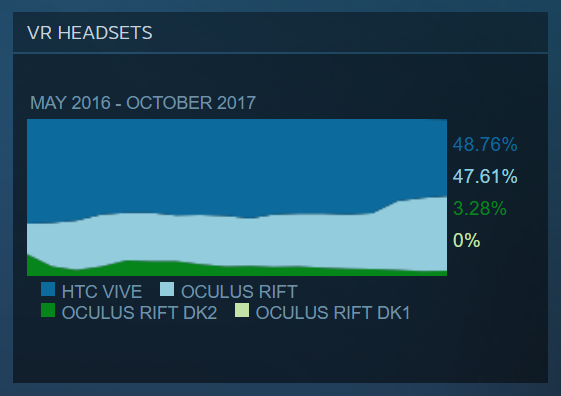According to the just-released October figures from Steam’s Hardware & Software Survey, the Oculus Rift has picked up an additional 0.71%, totalling 47.61% of the market share of VR headsets on Steam. With the price of the Rift dropping permanently to $400 last month, the headset has set its new record high for the fourth month in a row. The HTC Vive maintains a razor thin lead with 48.76% share of headsets in use on Steam.
Steam is the de facto content platform for the HTC Vive though it technically supports the Rift too; plenty of Rifters use both the official Oculus Home platform and Steam to play content which may not be available on the opposing platform.
Each month, Valve runs a survey among Steam users to determine some baseline statistics about what kind of hardware and software is used by the user population, and to see how things are changing over time; that includes which VR headsets are connected to users’ computers. Participation in the survey is optional.
The latest results show a small gain of 0.71% in the Rift’s share of VR headsets on Steam, bringing the device’s overall share to a new record high, reaching 47.61% of all headsets in use on the platform.

The gain was made up by a 1.44% reduction in Vive share, and, interestingly, the Rift DK2 development kit actually took some of that share and gained 0.28%. The latter, launched in 2014, still holds 3.28% total share of VR headsets in use on Steam. Combined, the consumer Rift and the Rift DK2 hold 50.89% of the Steam VR headset market share.
Though Steam is its primary content platform, the Vive only barely holds onto its lead against the Rift with 48.76% of all VR headsets on the platform, though now just 1.15% behind, the Rift could be on a trajectory for an upset.
Exactly how many Rift users use Steam among the total population of Rift users is unknown, making it largely futile to extrapolate the data in an effort to determine headset market share across all platforms. Many analyst estimates put the Vive ahead of the Rift in total sales, though in the consumer space, Oculus’ aggressive price cutting may have allowed the headset to gain significant ground. Oculus also recently introduced an ‘Oculus for Business’ package, attempting to capture some of the commercial market where Vive appears to have a strong.
The Rift’s latest 0.71% gain comes at the start of a newly lowered MSRP of $400, which Oculus announced on October 11th.
The latest figures could mean several things beyond just more headsets in users hands: A portion of the gains may have been made up not only by new headsets entering the market, but by more Rift users becoming aware of Steam’s compatibility with the Rift; another contributor could be the expansion of HTC’s Viveport app store and the Viveport subscription service, potentially drawing some Vive users away from Steam; still yet, some of the gains could have come from existing Vive owners using their headsets less, and/or existing Rift users using their headsets more (potentially driven by anticipated game launches or lack thereof).
While the Rift enjoyed significant buzz and gains in Steam market share surrounding a lengthy Summer sale, in August HTC brought a major price cut to Vive, setting its new baseline price at $600 (previously $800), which likely helped level out Oculus’ momentum. HTC said the price cut was not a reaction to the Rift sale.
The latest figures also report a 0.06% reduction in overall VR headset use, though given that we know that Oculus and HTC are still selling headsets, the most likely explanation there is that the rate of new non-VR users joining Steam is outpacing the rate of new VR users joining the service.
While the Rift and Vive fight it out on Steam, new competitors are soon to complicate the binary battle. The Windows VR headsets launched last month starting at $400; although the headsets are now available, their SteamVR compatibility won’t launch until December, which means we won’t likely see them register on the Steam Hardware & Software Survey until after the New Year.


 , Oculus Is Fending off Old Enemies, Former Friends, and New Foes
, Oculus Is Fending off Old Enemies, Former Friends, and New Foes




